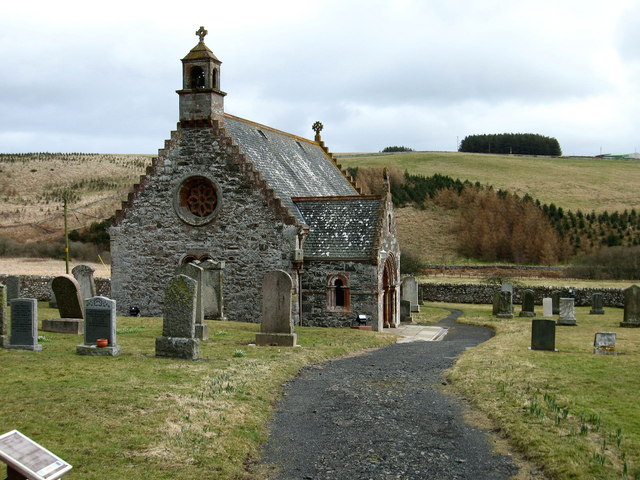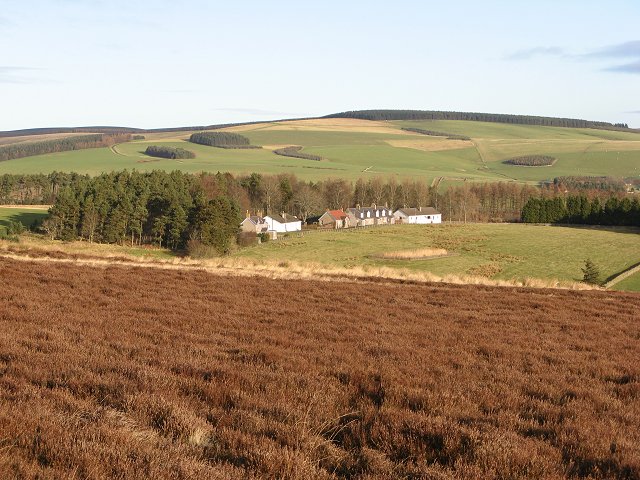 Chris Korte's New Zealand Genealogy Project
Chris Korte's New Zealand Genealogy Project
Cranshaws, Berwickshire, Scotland
About page
This page has information about Cranshaws in Berwickshire, southern Scotland. The parish of Cranshaws was the birth place of Thomas Redpath in 1829 and his mother Elizabeth Redpath in 1797. Thomas's father and oldest sister both died in the parish in 1864.
If you can provide additional information, or corrections, please contact (see Info menu).
Cranshaws
Cranshaws is a rural parish and hamlet in the Scottish Borders area of Scotland, in the former Berwickshire. There is no village in the parish. The landscape is hilly, and continues to be used for livestock farming.
The following description is from Frances Groome, Ordnance Gazetteer of Scotland (1882-4).
Cranshaws, a Lammermuir hamlet and parish in the N of Berwickshire. The hamlet lies, 676 feet above sea-level, on the right bank of Whitadder Water, 16 miles SE by E of Haddington, and 9 NW of Dunse, under which it has a post office. The parish consists of two sections, which are separated from each other by a strip (¾ mile broad at the narrowest) of Longformacus, and the northernmost of which contains the hamlet.
Including 30½ acres of water, the total area is 8738¼ acres, of which 2589 belong to the northern, and 6149¼ to the southern, portion. The Whitadder runs 3 miles on or near to the northern and eastern border of Cranshaws proper, whose highest points are Cranshaws Hill (1245 feet) and Mainslaughter Law (1381); whilst Dye Water runs 5 miles east-by-southward along all the northern boundary of the lower division, whose surface rises from less than 700 feet above sea-level to 1298 on Dunside Hill and 1522 on Blyth Edge. The rocks are Silurian; and much of the soil is poor, the arable land along the streams amounting to only some 900 acres.

19th Century Cranshaws
The following extract from THE NEW STATISTICAL ACCOUNT OF SCOTLAND give an idea of life in 19th Century Cranshaws. The following is extracted from the Cranshaws Parish article written in July 1834 by Rev. J. H. Sibbald, the parish minister of Cranshaws.
Meteorology - Fogs are here sometimes so dense and so regularly spread over all lower grounds, both in spring and autumn, as to mark a certain elevation over the whole country. The density of this vapour may be imagined from the fact, that a person descending from one of the neighbouring heights is seen from above, as if stepping deeper and deeper into water. So correctly is the surface line marked upon his person, and so complete is the deception, that the spectator is not without some degree of anxiety about his companion, whom he has seen walk over head into the abyss. When such fogs are partial, there is sometimes the appearance of a lake, with one or more streams connected with it.
Land owners - There are only three landed proprietors, Charles Watson, Esq. of Saughton; the Honourable Charles Stuart; and Duke of Roxburghe. The last having but a small property in the parish. There are two proprietors in the parish who hold lands to the amount of £50 per annum and upwards.
Population - In 1833 it does not appear to exceed - 100. The people generally marry early, and in consequence, we have neither male nor female unmarried above the ages of 50 and 45. They are generally very poor, but contented with their situation and circumstances, frugal, sober and industrious, generally regular in their attendance on religious ordinances, and, I am happy to add, that the form of godliness is observed in most of their families.
Agriculture - There are at present seven pairs of work-horses in the parish. The number of acres, therefore, under tillage, allowing fifty acres to each plough, will be 350, which, considering the nature of the land and climate, can scarcely be expected to furnish much produce for the market. More had been cultivated at one period, but was allowed to return to its original state, with the exception of a few patches, which are turned over occasionally, to renew the pasture. It is very doubtful whether the farmer would gain by keeping much more land under the plough, while the market prices are so low, all the roads in such a neglected state, and the distances to places of sale so great.
Livestock - The sheep are of the Cheviot breed, and amount to about 4400 in number; and the black-cattle a mixture of several kinds, in number from 70 to 80.
Ecclesiastical - Every family in this parish attends the Established church. The number of hearers may be about 100 or upwards. They are regular in their attendance, and very attentive during divine service. The number of communicants (inclusive of those from other parishes) varies from 80 to 100.
Education - We have no school but the parochial, in which all the usual branches of education are taught. The salary is the maximum, and the school fees amount to £10 per annum. The expense of education is from 10s. to 16s. per annum, according to the respective attainments of the scholars. The schoolmaster's house is a good one of two stories, and the garden of the legal extent. There is not an individual in the parish who has reached the age of 15 but can both read and write.
Fuel - The fuel in general use is peat and turf, which may cost about 1s. 6d. per cart, when ready for using, and 1s. more when brought home.
 |  |
| Cranshaws Kirk Rebuilt in 1899 | Cranshaws Cottages above the castle, moorland in the foreground. |
Page last updated on 23 July 2018.







